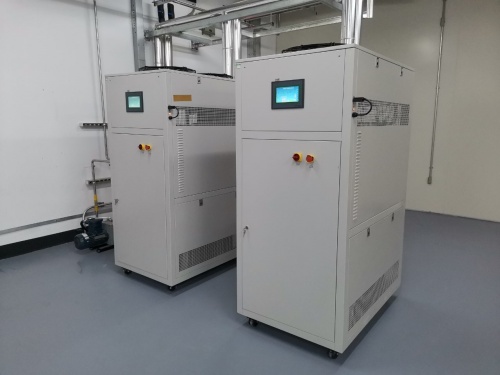Laboratory cooling heating circulators -20°C ~ 300°C
Laboratory cooling and heating circulators are widely used in the temperature range of -20°C to 300°C, especially for experiments in the fields of chemistry, pharmaceuticals, materials science and biotechnology that require precise temperature control. This equipment can provide a stable temperature environment to ensure the accuracy and repeatability of experimental results.

Main features
- Wide temperature range:
- Temperature range: -20°C to 300°C
- Such a temperature range can meet a variety of experimental needs from low-temperature crystallization to high-temperature reactions.
- High-precision temperature control:
- High-precision temperature control is achieved by using PID controllers or other advanced temperature control technologies.
- The control accuracy is usually ±0.1°C or less, ensuring temperature stability and consistency.
- Rapid heating and cooling capabilities:
- Heating: Heat the heat transfer medium (such as heat transfer oil or water/ethylene glycol mixture) through an electric heater.
- Cooling: Cool the heat transfer medium to the required temperature through compressor refrigeration.
- Rapid heating and cooling capabilities can improve experimental efficiency, especially when temperature conditions need to be changed frequently.
- Circulation pump:
•Circulate the heat transfer medium between the heating/cooling unit and the reactor to ensure uniform temperature distribution.
•The flow rate of the circulation pump should match the needs of the experimental equipment, usually between a few liters per minute and tens of liters per minute.
- Safety protection measures:
•Overtemperature protection: Automatically cut off the power supply when the temperature exceeds the set value.
•Overpressure protection: Prevent the system pressure from being too high.
•Leak detection: Detect whether the system has leaks.
•Emergency stop button: Quickly stop the system operation in an emergency.
- User interface:
•Touch screen or digital display: Intuitively display the current temperature, set temperature and other parameters.
•User-friendly operation interface: Easy to set and monitor temperature, support programming and data recording functions
Application areas
- Chemical synthesis:
•Carry out chemical reactions under different temperature conditions to improve the selectivity and yield of the reaction.
•Applicable to organic synthesis, inorganic synthesis, etc.
- Material science:
•Prepare new materials under different temperature conditions and explore material properties.
•Applicable to the research of nanomaterials, composite materials, etc.
- Pharmaceutical industry:
- In the process of drug synthesis and purification, the reaction needs to be carried out at a specific temperature to ensure the quality and consistency of the product.
- Applicable to the synthesis of drug intermediates and active ingredients.
- Biotechnology:
- In biological experiments, the temperature needs to be precisely controlled to ensure the smooth progress of processes such as cell culture and enzyme catalysis.
- Applicable to cell culture, protein purification, etc.
- Physical research:
- In physical experiments, the physical properties of substances need to be studied under different temperature conditions.
- Applicable to the research of magnetic materials, semiconductor materials, etc.
Selection points
- Temperature range:
- Make sure that the equipment can cover the required temperature range (-20°C to 300°C).
- Heating and cooling capacity:
- Select heating and cooling power suitable for the capacity of the experimental equipment and the required temperature change rate.
- Temperature control accuracy:
- Select a system with high-precision temperature control, such as a PID controller, to ensure temperature stability.
- Circulation pump flow rate:
- Select a circulation pump flow rate suitable for the capacity of the experimental equipment to ensure uniform temperature distribution.
- Safety:
- Ensure that the system has multiple safety protection measures to ensure the safety of operators and equipment.
- Maintenance cost:
- Choose a system that is easy to maintain and operate to reduce long-term operating costs.
Summary Laboratory cooling and heating circulators are widely used in the temperature range of -20°C to 300°C, and can provide precise temperature control to ensure the accuracy and repeatability of experimental results. By selecting the appropriate heating and cooling capacity, circulation pump flow rate and high-precision temperature control system, the needs of different experiments can be met.
 Industrial Chiller Heater Equipment Supplier-LNEYA
Industrial Chiller Heater Equipment Supplier-LNEYA
